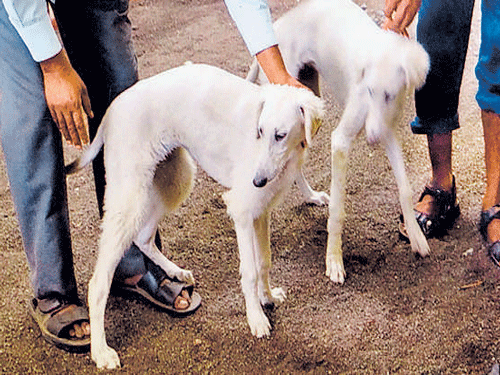
The Mudhol Hound has had a very royal start, given that it was the preferred breed of dogs by the royalty for warfare, hunting and companionship.
Humans and hounds have had a very ancient friendship. Hounds are believed to have originated in the Middle East. The Bedouin tribes of North Africa and Asia are known to have bred such dogs in the past.
Many Egyptian antiquities have the hound motifs for decoration, indicating that they were the favourites of the Pharaohs as well. When the Egyptian royalty died, their hounds, too, were often buried next to them. Saluki (Arabic) means 'hound'. So, these dogs also go by the names ‘Salukis’ or ‘Pharaoh Hounds’.
These hounds are from the family of sight hounds, not the scent hounds. Scent hounds, which include Blood Hounds and Beagles, have a powerful sense of smell to hunt their prey.
On the other hand, the Sight Hounds have a powerful vision, so they hunt, primarily, by way of sight and speed. They have characteristic long legs, deep chest and narrow waist. These dogs specialise in pursuing their prey, keeping it in sight and overpowering it with their speed and agility.
The famed Silk Route traversed the ancient civilisations of China, India, Persia, Arabia, Egypt, and onwards to Greece and Rome. Traders, who dealt in gold, silks, precious stones and spices, moved in caravans or in groups consisting of more than a hundred oxen carts, camels, horses, tents, and their own security contingents. They also had their own dogs accompanying them; these were usually hunting dogs or the Arabian and Afghan Hounds.
The inter-breeding of these produced ‘Karavani Hounds’, literally meaning “hounds accompanying traders’ caravans”, and later came to be known as ‘Caravan Hounds’.So, we see that the hound of the desert, now called Caravan Hound, had already made its way into the Indian sub-continent with these traders.
The fabled riches and magnificence of India soon attracted marauders from across the Hindu Kush. The Greeks, Persians, Turks and Moguls, at different times, invaded India. These invading armies were always accompanied by their hounds for reconnaissance and
sighting of the enemy. They took as much pride in grooming their dogs as they did their horses. The Maratha Sardars, too, loved the hounds and trained them in mountain warfare.
In fact, these dogs were constant companions to Shivaji, and so, they were even buried next to his samadhi at Raighad Fort in Maharashtra. That is the reason these hounds came to be known as ‘Maratha Hounds’ as well.
With the advent of the British there was a decline in interest in these hounds,
because the British brought with them their own exotic breeds to India. It was Shrimant Rajesaheb Malojirao Ghorpade of Mudhol [1884-1937] who took up the challenge of reviving this breed. He noticed that local tribes around Mudhol, on the Deccan Plateau in North,
Karnataka, and surrounding areas nurtured these dogs and trained them for game hunting. He devised a programme of selective inbreeding and restored the hounds to their once royal glory.
In the early 1900s, the nobility in England loved hunting for sport and used Grey Hounds, a different breed, for the purpose. Raja Malojirao Ghorpade, on a visit to England, presented King George V a pair of hounds from his kennels in Mudhol. The king was delighted; he
christened them ‘Mudhol Hounds’.
Today Mudhol Hound is a popular breed and much in demand among dog lovers all over India. The Mysore Kennel Club in Bengaluru deserves praise for popularising this breed. The Government of Karnataka has set up a Canine Research and Information Centre, near Mudhol for breeding these indigenous hounds.